Step-Double-Zone-JTE for SiC Devices with Increased Tolerance to JTE Dose and Surface Charges
Abstract
:1. Introduction
2. Materials and Methods
2.1. Device Structure
2.2. Fabrication Procedure
3. Results
3.1. Simulation Optimization of the DZ-JTE
3.2. Simulation Optimization of the Step-DZ-JTE with FP
3.3. Compare Electric Field Distribution
4. Discussion
5. Conclusions
Author Contributions
Funding
Conflicts of Interest
References
- Shenai, K.; Scott, R.S.; Baliga, B.J. Optimum semiconductors for high-power electronics. IEEE Trans. Electron. Devices 1989, 36, 1811–1823. [Google Scholar] [CrossRef]
- Elasser, A.; Chow, T.P. Silicon carbide benefits and advantages for power electronics circuits and systems. Proc. IEEE 2002, 90, 969–986. [Google Scholar] [CrossRef] [Green Version]
- Kimoto, T. Ultrahigh-voltage SiC devices for future power infrastructure. In Proceedings of the 2013 Proceedings of the European Solid-State Device Research Conference, Bucharest, Romania, 16–20 September 2013; pp. 22–29. [Google Scholar] [CrossRef]
- Casady, J.B.; Johnson, R.W. Status of silicon carbide (SiC) as a wide-bandgap semiconductor for high-temperature applications: A review. Solid-State Electron. 1996, 39, 1409–1422. [Google Scholar] [CrossRef]
- Buttay, C.; Raynaud, C.; Morel, H.; Civrac, G.; Locatelli, M.L.; Morel, F. Thermal stability of silicon carbide power diodes. IEEE Trans. Electron. Devices 2012, 59, 761–769. [Google Scholar] [CrossRef]
- Shankar, B.; Gupta, S.K.; Taube, W.R.; Akhtar, J. High-k dielectrics based field plate edge termination engineering in 4H-SiC Schottky diode. Int. J. Electron. 2016, 103, 2064–2074. [Google Scholar] [CrossRef]
- Tarplee, M.C.; Madangarli, V.P.; Zhang, Q.; Sudarshan, T.S. Design rules for field plate edge termination in SiC Schottky diodes. IEEE Trans. Electron. Devices 2001, 48, 2659–2664. [Google Scholar] [CrossRef]
- Brunt, E.V.; Cheng, L.; O’Loughlin, M.; Capell, C. 22 kV, 1 cm2, 4H-SiC n-IGBTs with improved conductivity modulation. In Proceedings of the International Symposium on Power Semiconductor Devices & Ic’s, Waikoloa, HI, USA, 15–19 June 2014; pp. 358–361. [Google Scholar] [CrossRef]
- Villamor-Baliarda, A.; Vanmeerbeek, P.; Roig, J.; Moens, P. Electric field unbalance for robust floating ring termination. Microelectron. Reliab. 2011, 51, 1959–1963. [Google Scholar] [CrossRef]
- Sung, W.; Baliga, B.J. A Near Ideal Edge Termination Technique for 4500V 4H-SiC Devices: The Hybrid Junction Termination Extension (Hybrid-JTE). IEEE Electron. Device Lett. 2016, 37, 1609–1612. [Google Scholar] [CrossRef]
- Mahajan, A.; Skromme, B.J. Design and optimization of junction termination extension (JTE) for 4H SiC high voltage Schottky diodes. Solid State Electron. 2005, 49, 945–955. [Google Scholar] [CrossRef]
- Okayama, T.; Arthur, S.D.; Rao, R.R.; Kishore, K.; Rao, M.V. Stability and 2-D Simulation Studies of Avalanche Breakdown in 4H-SiC DMOSFETS with JTE. IEEE Trans. Electron Devices. 2008, 55, 489–494. [Google Scholar] [CrossRef]
- Zhang, F.; Xing-Hua, F.U. Simulation study on 4H-SiC Schottky diode with JTE structure. In Proceedings of the 2014 16th European Conference on Power Electronics and Applications, Lappeenranta, Finland, 26–28 August 2012. [Google Scholar]
- Feng, G.; Suda, J.; Kimoto, T. Space-Modulated Junction Termination Extension for Ultrahigh-Voltage p-i-n Diodes in 4H-SiC. IEEE Trans. Electron. Devices 2012, 59, 414–418. [Google Scholar] [CrossRef]
- Deng, X.; Li, L.; Wu, J.; Li, C.; Chen, W. A Multiple-Ring-Modulated JTE Technique for 4H-SiC Power Device with Improved JTE-Dose Window. IEEE Trans. Electron. Devices 2017, 64, 5042–5047. [Google Scholar] [CrossRef]
- Perez, R.; Tournier, D.; Perez-Tomas, A.; Godignon, P.; Mestres, N. Planar edge termination design and technology considerations for 1.7-kV 4H-SiC PiN diodes. IEEE Trans. Electron. Devices 2005, 52, 2309–2316. [Google Scholar] [CrossRef]
- Perez, R.; Mestres, N.; Tournier, D. A highly effective edge termination design for SiC planar high power devices. Mater. Sci. Forum 2014, 457–460, 1253–1256. [Google Scholar] [CrossRef]
- Zhang, F.; Li, X. Research on high-voltage 4H-SiC P-i-N diode with planar edge junction termination techniques. Chin. Phys. B 2011, 20, 366–371. [Google Scholar] [CrossRef]
- Huang, R.; Tao, Y.; Wang, L.; Chen, G.; Bai, S. Development of g10kv 4H-SiC SBD junction extension termination. In Proceedings of the International Conference on Advanced Electronic Science and Technology, Shenzhen, China, 19–21 August 2016. [Google Scholar] [CrossRef]
- Sheridan, D.C.; Niu, G.; Cressler, J.D. Design of single and multiple zone junction termination extension structures for SiC power devices. Solid-State Electron. 2001, 45, 1659–1664. [Google Scholar] [CrossRef]
- Sung, W.; Brunt, E.V.; Baliga, B.J.; Huang, A.Q. A new edge termination technique for high-voltage devices in 4H-SiC–multiple-floating-zone junction termination extension. IEEE Electron. Device Lett. 2011, 32, 880–882. [Google Scholar] [CrossRef]
- Ghandi, R.; Buono, B.; Domeij, M.; Zetterling, C.M. High-Voltage 4H-SiC PiN Diodes with Etched Junction Termination Extension. IEEE Electron. Device Lett. 2009, 30, 1170–1172. [Google Scholar] [CrossRef]
- Pâques, G.; Dheilly, N.; Planson, D.; Scharnholz, S. Graded Etched Junction Termination for SiC Thyristors. Mater. Sci. Forum 2011, 679–680, 457–460. [Google Scholar] [CrossRef]
- Huang, C.F.; Hsu, H.C.; Chu, K.W.; Lee, L.H.; Tsai, M.J. Counter-Doped JTE, an Edge Termination for HV SiC Devices with Increased Tolerance to the Surface Charge. IEEE Trans. Electron. Devices 2015, 62, 354–358. [Google Scholar] [CrossRef]
- Kaji, N.; Niwa, H.; Suda, J.; Kimoto, T. Ultrahigh-Voltage SiC p-i-n Diodes with Improved Forward Characteristics. IEEE Trans. Electron. Devices 2015, 62, 374–381. [Google Scholar] [CrossRef]
- Deng, X.; Chen, X.; Li, C.; Shen, H.; Zhang, J. Numerical and experimental study of the mesa configuration in high-voltage 4H–SiC PiN rectifiers. Chin. Phys. B 2016, 25, 087201. [Google Scholar] [CrossRef]
- Baliga, B.J. Fundamentals of Power Semiconductor Devices; Springer: New York, NY, USA, 2008; Chapter 3; pp. 91–155. [Google Scholar] [CrossRef]
- Kim, S.C.; Bahng, W.; Kang, I.H. Fabrication characteristics of 1.2 kV SiC JBS diode. In Proceedings of the International Conference on Microelectronics, Nis, Serbia & Montenegro, 11–14 May 2008; pp. 181–184. [Google Scholar]
- Hiyoshi, T.; Hori, T.; Suda, J. Simulation and Experimental Study on the Junction Termination Structure for High-Voltage 4H-SiC PiN Diodes. IEEE Trans. Electron. Devices 2008, 55, 1841–1846. [Google Scholar] [CrossRef] [Green Version]
- Wang, C.; Yuan, H.; Song, Q. Fabrication of 3.1 kV/10 A 4H-SiC Junction Barrier Schottky Diodes. In Proceedings of the 2015 IEEE 11th International Conference on ASIC (ASICON), Chengdu, China, 3–6 November 2015; pp. 1–3. [Google Scholar]
- Lee, C.Y.; Yen, C.T.; Chu, K.W.; Chen, Y.S. A novel 4H-SiC Trench MOS Barrier Schottky rectifier fabricated by a two-mask process. In Proceedings of the International Symposium on Power Semiconductor Devices and ICS, Kanazawa, Japan, 26–30 May 2013; pp. 171–174. [Google Scholar] [CrossRef]

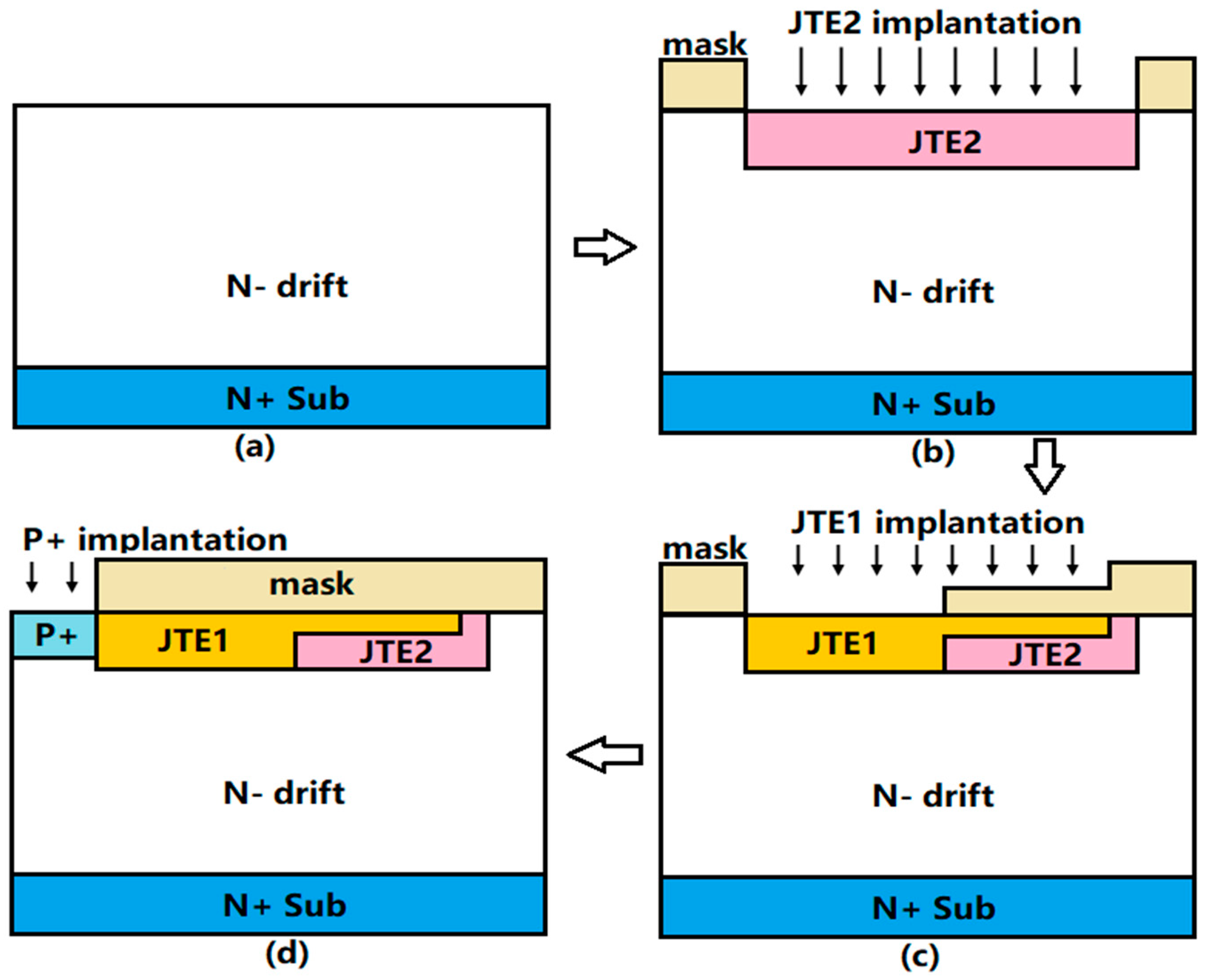
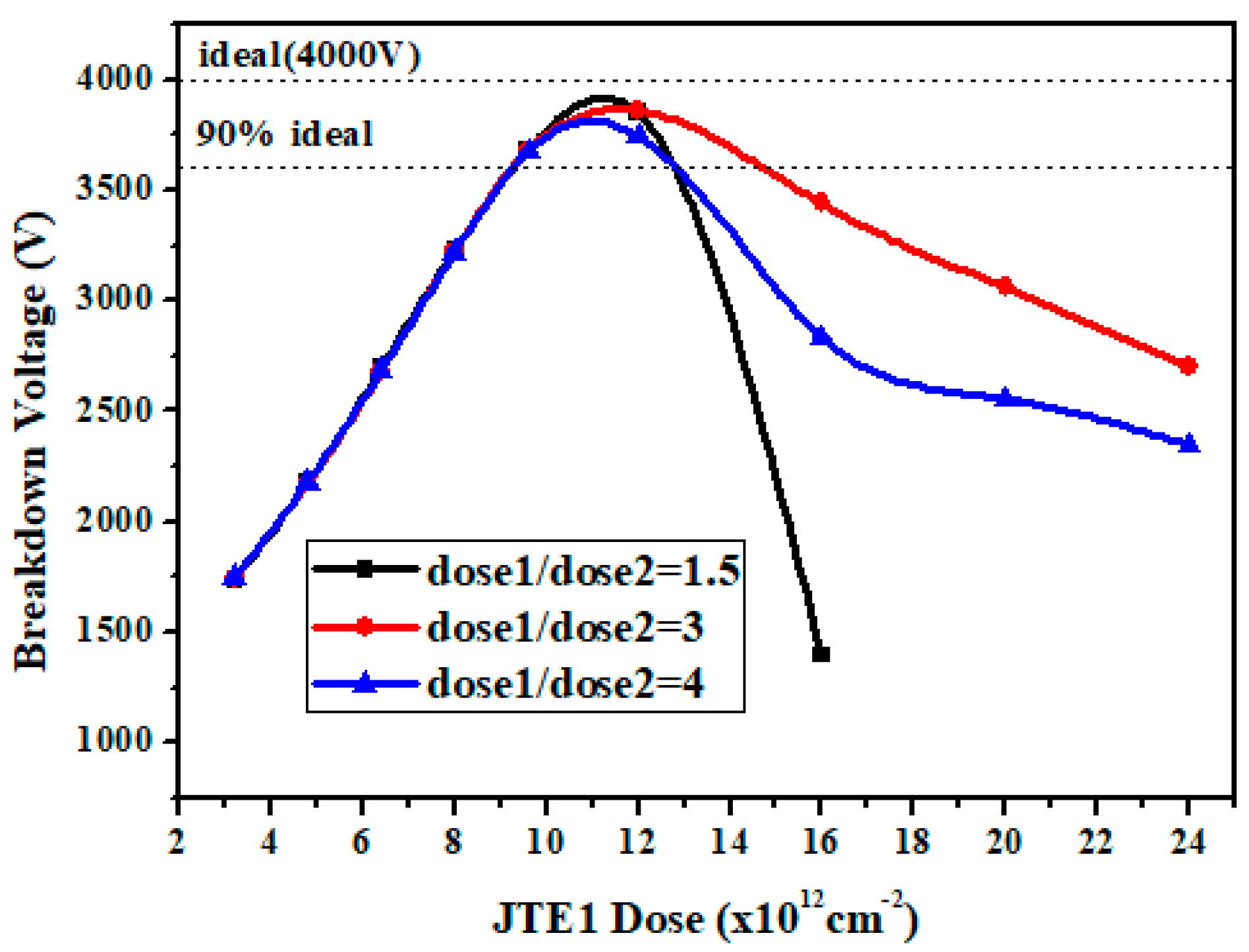

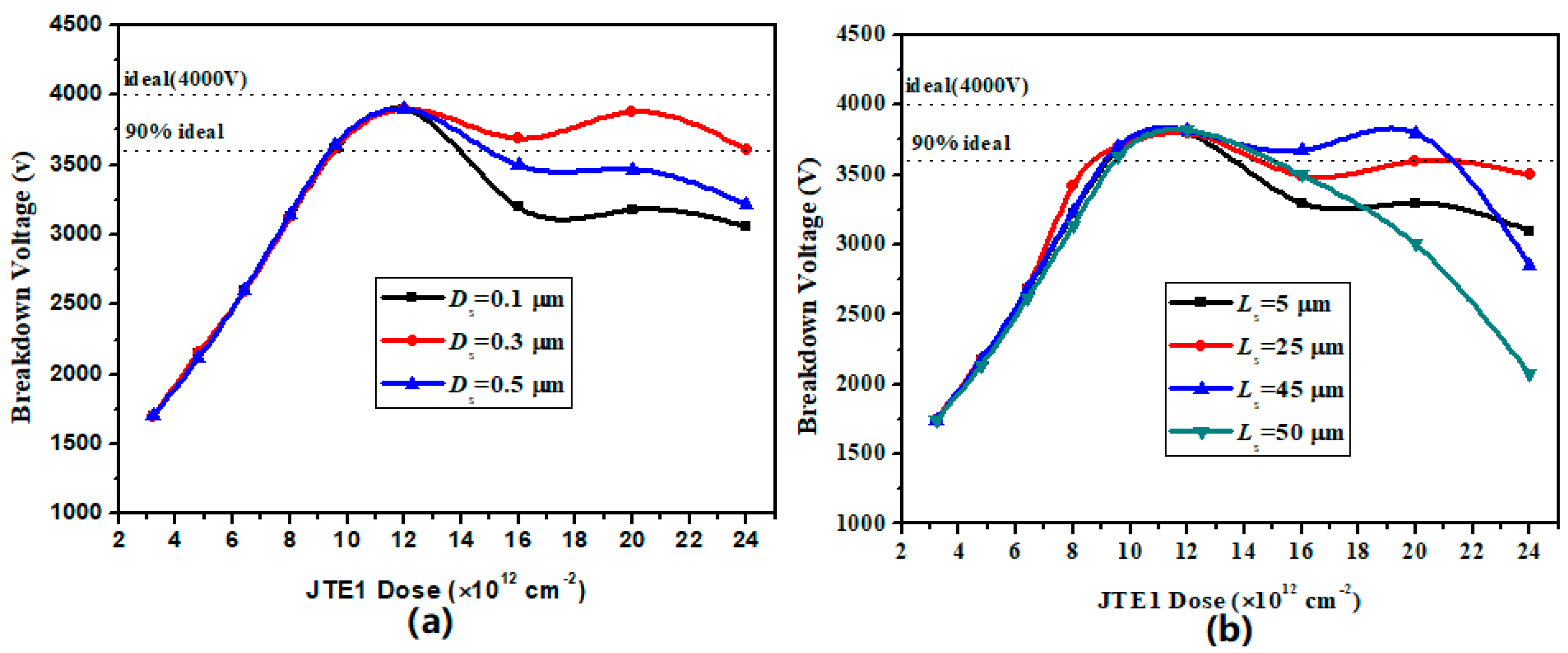

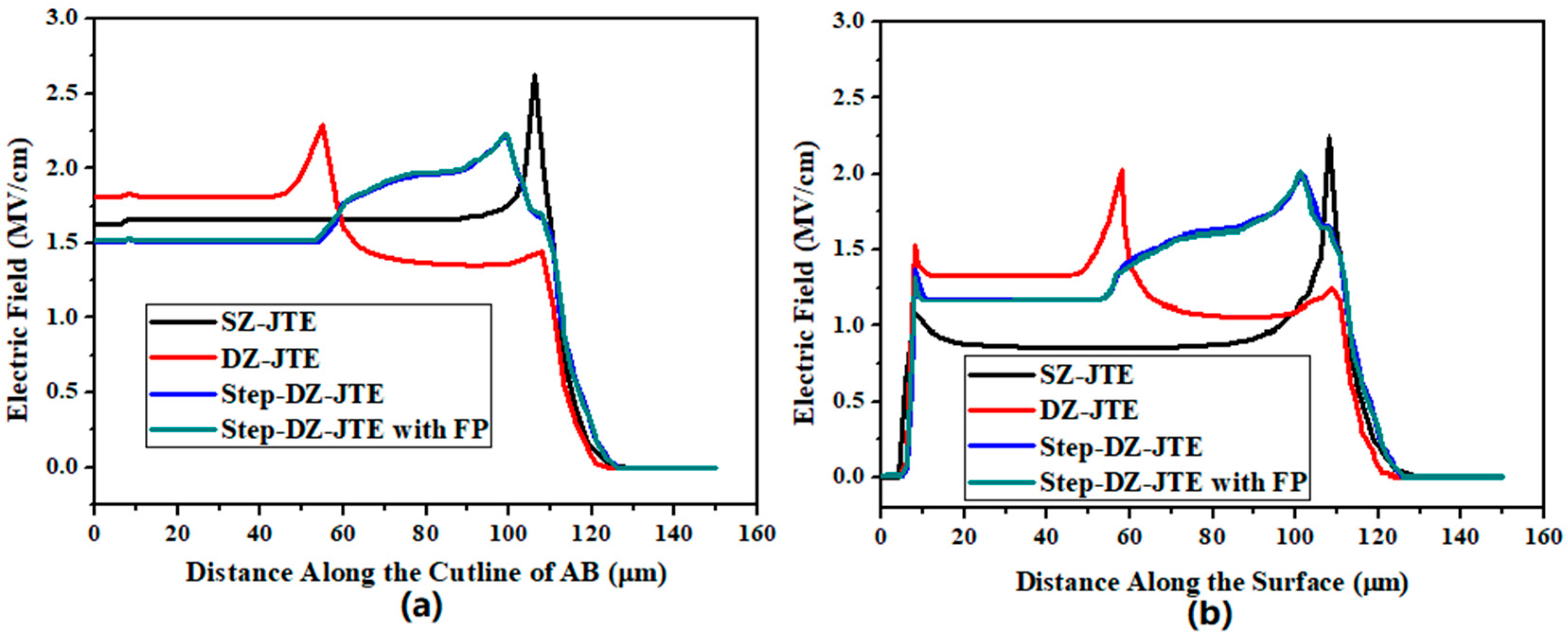

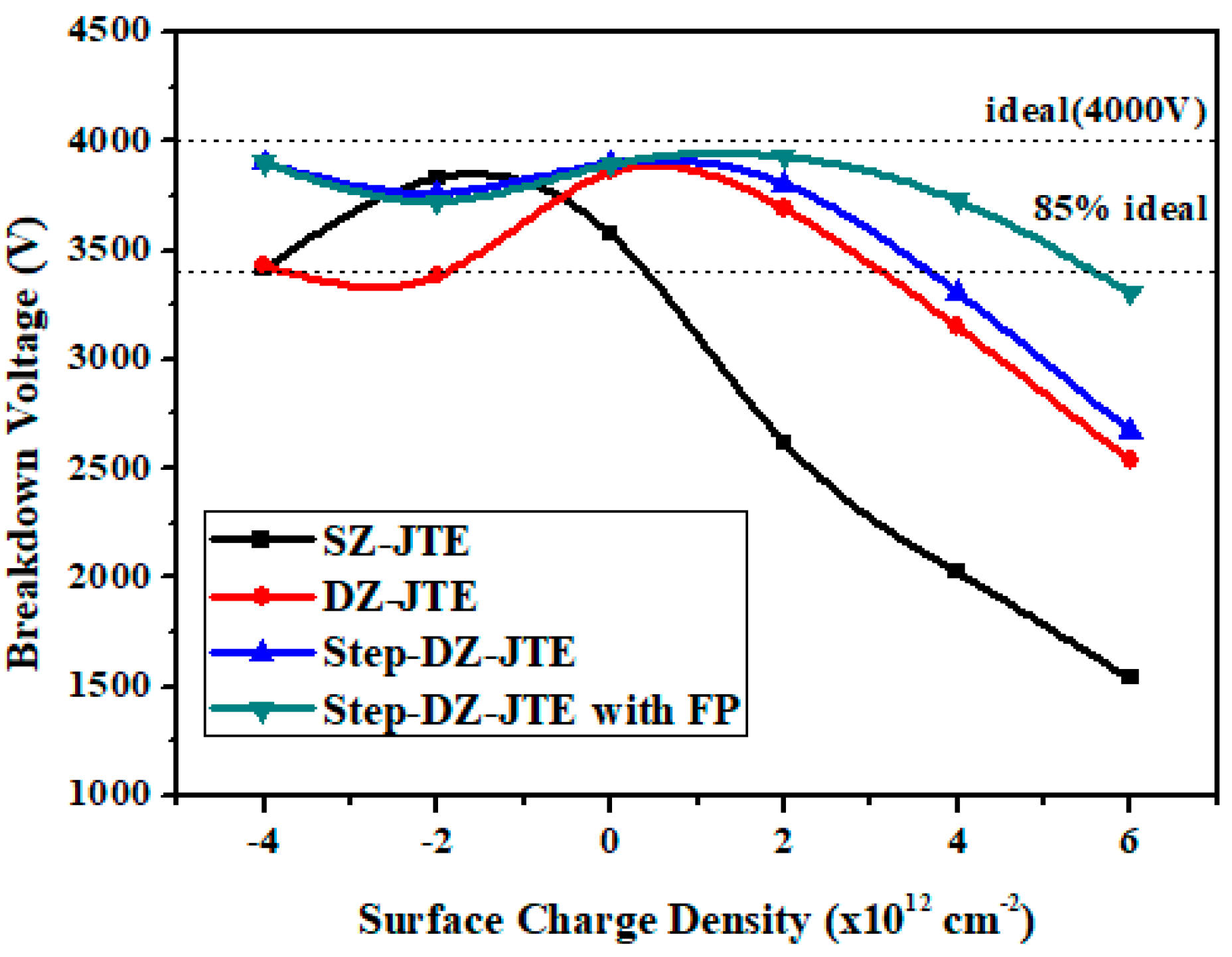
| Parameter | Value |
|---|---|
| P+ anode junction depth | 0.6 μm |
| Junction termination extension (JTE) junction depth | 0.8 μm |
| Depth of the step JTE (Ds) | 0.3 μm |
| Length of the step JTE (Ls) | 45 μm |
| Length of the anode FP (Wfp) | 20 μm |
| Thickness of drift | 30 μm |
| n- drift dopant concentration (ND) | 3.0 × 1015 cm−3 |
| p+ anode dopant concentration (NA) | 1.0 × 1019 cm−3 |
| Structures | SZ-JTE | DZ-JTE | Step-DZ-JTE | Step-DZ-JTE with FP |
|---|---|---|---|---|
| JTE total length (μm) | 100 | 100 | 100 | 100 |
| Number of p-type implant | 1 | 2 | 2 | 2 |
| JTE1 dose tolerance for 90% BV (× 1012 cm−2) | 0.4 | 4.1 | 12.2 | 13.8 |
| Total JTE dose tolerance for 90% BV ((× 1012 cm−2) | 0.4 | 5.6 | 16.3 | 18.4 |
| The percentage of positive and negative variation | (+2.2%, −2.2%) | (+17.5%, −17.0%) | (+75%, −18.4%) | (+75%, −35%) |
| Max. positive SC density for 85% BV (× 1012 cm−2) | 0.5 | 3.2 | 3.7 | 5.5 |
© 2018 by the authors. Licensee MDPI, Basel, Switzerland. This article is an open access article distributed under the terms and conditions of the Creative Commons Attribution (CC BY) license (http://creativecommons.org/licenses/by/4.0/).
Share and Cite
Huang, Y.; Wang, Y.; Kuang, X.; Wang, W.; Tang, J.; Sun, Y. Step-Double-Zone-JTE for SiC Devices with Increased Tolerance to JTE Dose and Surface Charges. Micromachines 2018, 9, 610. https://doi.org/10.3390/mi9120610
Huang Y, Wang Y, Kuang X, Wang W, Tang J, Sun Y. Step-Double-Zone-JTE for SiC Devices with Increased Tolerance to JTE Dose and Surface Charges. Micromachines. 2018; 9(12):610. https://doi.org/10.3390/mi9120610
Chicago/Turabian StyleHuang, Yifei, Ying Wang, Xiaofei Kuang, Wenju Wang, Jianxiang Tang, and Youlei Sun. 2018. "Step-Double-Zone-JTE for SiC Devices with Increased Tolerance to JTE Dose and Surface Charges" Micromachines 9, no. 12: 610. https://doi.org/10.3390/mi9120610




